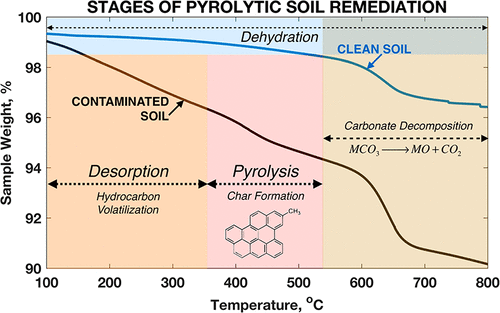当前位置:
X-MOL 学术
›
Ind. Eng. Chem. Res.
›
论文详情
Our official English website, www.x-mol.net, welcomes your feedback! (Note: you will need to create a separate account there.)
Pyrolytic Remediation of Oil-Contaminated Soils: Reaction Mechanisms, Soil Changes, and Implications for Treated Soil Fertility
Industrial & Engineering Chemistry Research ( IF 4.2 ) Pub Date : 2018-03-01 00:00:00 , DOI: 10.1021/acs.iecr.7b04651 Julia E. Vidonish , Pedro J. J. Alvarez , Kyriacos Zygourakis
Industrial & Engineering Chemistry Research ( IF 4.2 ) Pub Date : 2018-03-01 00:00:00 , DOI: 10.1021/acs.iecr.7b04651 Julia E. Vidonish , Pedro J. J. Alvarez , Kyriacos Zygourakis

|
Pyrolysis of hydrocarbon-contaminated soils offers the potential for rapid remediation without destroying soil fertility. Here we elucidate the fundamental mechanisms of pyrolytic treatment and advance understanding of the surface properties of pyrolyzed soils. Using thermogravimetry and evolved gas analysis, we identified the two stages of pyrolytic remediation. Desorption of light hydrocarbons is the dominant process for temperatures between 150 and 350 °C. Pyrolysis reactions dominate in the 400–500 °C range releasing gaseous products (hydrogen, methane, higher alkanes, and olefins) and forming a solid char. XPS analysis and partial combustion revealed that the char forms a layer coating the particles of treated soils. Since pyrolysis can effectively reduce the TPH of contaminated soils at temperatures below 500 °C, it avoids carbonate decomposition reactions that may lead to large soil pH increases and severe loss of fertility. This is a significant potential advantage over competing thermal processes that expose contaminated soil to temperatures above 500 °C.
中文翻译:

石油污染土壤的热解修复:反应机理,土壤变化及其对土壤肥力的影响
碳氢化合物污染的土壤的热解提供了快速修复而不破坏土壤肥力的潜力。在这里,我们阐明了热解处理的基本机理,并进一步了解了热解土壤的表面性质。使用热重分析和逸出气体分析,我们确定了热解修复的两个阶段。轻烃的解吸是150至350°C之间温度的主要过程。热解反应在400-500°C的温度范围内占主导地位,释放出气态产物(氢气,甲烷,高级烷烃和烯烃)并形成固体焦炭。XPS分析和部分燃烧表明,炭形成了一层覆盖处理过的土壤颗粒的层。由于热解可以有效降低温度低于500°C的被污染土壤的TPH,它避免了碳酸盐分解反应,而碳酸盐分解反应可能会导致土壤pH值大幅升高并严重丧失肥力。与竞争性热工艺相比,这具有显着的潜在优势,而竞争性热工艺会使受污染的土壤暴露于500°C以上的温度。
更新日期:2018-03-01
中文翻译:

石油污染土壤的热解修复:反应机理,土壤变化及其对土壤肥力的影响
碳氢化合物污染的土壤的热解提供了快速修复而不破坏土壤肥力的潜力。在这里,我们阐明了热解处理的基本机理,并进一步了解了热解土壤的表面性质。使用热重分析和逸出气体分析,我们确定了热解修复的两个阶段。轻烃的解吸是150至350°C之间温度的主要过程。热解反应在400-500°C的温度范围内占主导地位,释放出气态产物(氢气,甲烷,高级烷烃和烯烃)并形成固体焦炭。XPS分析和部分燃烧表明,炭形成了一层覆盖处理过的土壤颗粒的层。由于热解可以有效降低温度低于500°C的被污染土壤的TPH,它避免了碳酸盐分解反应,而碳酸盐分解反应可能会导致土壤pH值大幅升高并严重丧失肥力。与竞争性热工艺相比,这具有显着的潜在优势,而竞争性热工艺会使受污染的土壤暴露于500°C以上的温度。



























 京公网安备 11010802027423号
京公网安备 11010802027423号